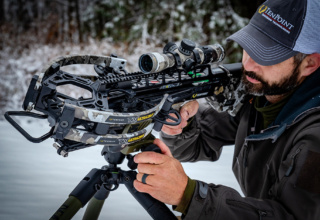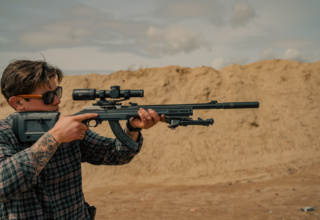The first day of the Missouri spring turkey season had begun and I found myself reluctant to get close to any approaching gobbling toms. My hesitation was due to a late spring that had prevented any green foliage from blooming out on to any of the trees and brush that I was surrounded by. Due to the lay of the land, I knew that taking a longer way around approach would be the only option in getting close enough to set up to call without being seen. After making my way around to the side of a hill, I was able to crest it and was in a perfect location to start calling. From my setup point, I could see the standing timber in which I knew a gobbling tom should be. My intuition happened to be right and I was pleased to hear the gobble of a turkey within proximity to my location. With a slight enough hill to keep him out of sight, I crawled on my hands and knees to a nearby tree, eased my knee up into place then made a few soft yelps on a diaphragm call. After a couple of thundering gobbles, I could tell the tom was on his way. A few minutes later the gobbler stuck his head up like that of periscope, looking out into the field to see where the hen was making the soft yelps. This curious look was all I needed to make a clear shot at a mere 15 yards.

Hunting open areas such as crop fields, cow pastures and as in my case, open timber during the early spring can be challenging when trying to stay concealed from a turkey’s keen eyesight. In my situation, I was hunting open areas due to the lack of cover on the trees. Late blooming trees happen every so often in Missouri and as someone who is used to this area, I have learned to deal with it. However, there are western states such as Kansas and Oklahoma that have very little trees at all, forcing turkeys to live in the open fields daily. Hunters that frequent these western areas tend to be curious as to how it is possible to get close enough for a shot on these wide-open area birds and they also wonder how they can stay hidden when they are attempting to make a shot. In fact, are western turkeys a bird that can be hunted at all due to huge open areas that they frequent? The simple answer is yes. Here a few tips and tricks that will help when faced with these obstacles.
As with my hunt in Missouri, having an entry and exit route to one’s desired location is a must in order to stay out of sight of any turkeys that may be in the area. Using the landscape is the best way to make this type of approach. By scouting before season, the hunter can find creek beds, patches of timber and hill sides that can be used to approach an area in a sort of stealth mode to stay concealed from any wildlife. Another great item to have is a quality pair of optics. I prefer using Nikon’s Laser Force binoculars which is an 8×10 binocular with a built-in range finder. With these optics, I have used landscapes such as open power lines to slowly make my way to a gobbling tom. When performing this tactic, I will walk a few steps slowly and then glass the area to make sure there is no other turkeys in the open that might spoil my chances of getting close to the tom. I will use the Laser Forces built in range finder to mark the landscape to see how far I have traveled or how far I need to go, all the while planning my steps as I go. The key is taking the time, while slowly gaining ground in order to be able to set up and call.

Another great option for hunting in open areas such as fields is that of using a ground blind. Again, if one will scout an area prior to hunting in order to find out the best location for getting close to turkeys followed by setting up a blind a few days before, it will allow time for turkeys to become comfortable. When the times comes to hunt, the hunter will want to approach the blind several minutes before turkeys began waking up on the roost, this will prevent being seen once daylight begins to arrive. Using the same stealth-like approach even well before sunrise is recommended to prevent any nearby roosted birds from spotting the hunter. By having a blind already in place when turkeys arrive in the field, the hunter will be able to begin calling while still staying concealed. When using a ground blind in open areas, I also like to use multiple decoys, preferably 2 or 3. I like to use the Avian X HDR Jake with an Avian X LCD Lookout hen and sometimes I will add an LCD Feeder Hen decoy. This type of set up can be seen at a long distance by approaching turkeys. This realistic setup does exactly what decoys were designed to do, which is to keep the attention off the hunter.
If using a ground blind is not an option, or if one likes a more mobile style of hunting, there are still ways to be able to set up in more open areas. The folks at ALPS Outdoorz have developed the Grand Slam Turkey Vest which is equipped with an adjustable stand, making it possible to set up virtually anywhere. I have experienced this type of setup while predator hunting. Having the ability to sit with a vest that has a stand for a back rest makes it possible to set up in brush, tall grass and when only a few trees are present. The Grand Slam Turkey Vest allows me to use what trees are available as extra cover instead of using said trees as a back rest. This vest is also great to use when performing a run and gun method of hunting. Moving along the edge of a field while stopping randomly to call is made possible with this vest. When one does strike a gobble, flip out the stand of the Grand Slam Turkey Vest and sit down. Being such a versatile vest gives the hunter an edge when hunting open terrain turkeys.

The last tactic to remember when hunting open area gobblers is to use higher volume calls, especially when hunting western states. Open areas usually produce a lot of wind which results in turkeys struggling to hear. If one will use a high-pitched call such as a glass pot call or a box call, the sound will cut through the wind, making it easier for turkeys to hear. When hunting out of a ground blind, using these types of friction calls more frequently than normal is recommended thus being inside of a ground blind while doing so will help keep the hunter hidden when calling. The two things to remember when hunting open areas is to call loud and call often.
Hunting in open areas can be a challenging task if one does not take the steps necessary to stay hidden. If a hunter will take advantage of the above listed tips and tactics, the challenge will seem like less of a hassle while on the next open area hunt.
















